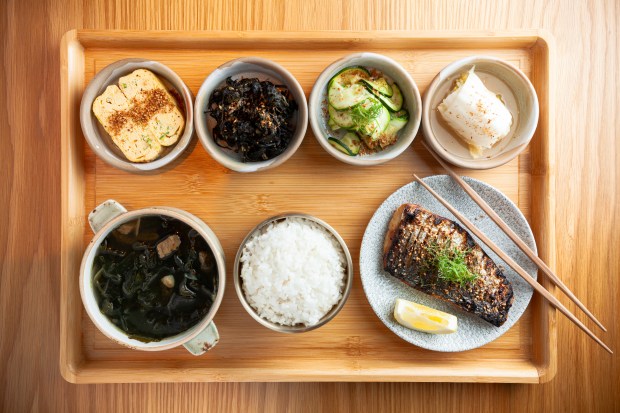As we dive straight into 2025, the Tribune food team offers looks at three notable restaurants that opened in 2024.
Below, read our un-starred reviews in alphabetical order for Perilla Steakhouse, Sando Street and Santa Masa Tamaleria.
— Kayla Samoy, food editor
Perilla Steakhouse
Barbecue, steakhouse, grill — such simple words can mean many different things to people. It’s in the space between that Perilla Steakhouse in the Loop experiments, with plenty of room to grow into ever-exciting new possibilities.
Executive chef Andrew Lim and General Manager Thomas Oh said their second restaurant, which opened in July inside the luxury hotel L7 Chicago by Korean megacorporation Lotte, is a “Korean American” interpretation of a steakhouse.
Perilla Steakhouse takes bits and pieces from KBBQ, well-heeled steakhouses and hip fine dining spots and remixes them into an experience that is frictionless and unexpected. The restaurant can be experienced in a wide variety of ways, from solo dining to a more communal eating experience.
“Realistically, we want people to share the entirety of the menu,” Oh said.
“Even when we go to Chicago steakhouses, that’s how we eat,” Lim said. “We share.”
In contrast to the dark, dimly lit steakhouse, the decor and design of Perilla feels open with subtle elements of Korean artisanal woodwork and breathable rattan-backed chairs. With my group of five, we ordered communally, but we all remarked how it felt different from ordering at a traditional KBBQ spot. For brunch, we shared the World Famous Pancakes ($15) (not to be confused with Korean-style savory pancakes), cacio e pepe rice cakes ($18), the premium steak set ($65) and a slice of chocolate cake ($15). I also ordered the Korean lunch tray ($26) with grilled mackerel.
The ricotta buttermilk pancakes were perfectly fluffy with a subtle aroma coming from the perilla-infused maple syrup. The lunch tray was beautifully laid out, but unfortunately, the mackerel, usually a favorite of mine at Korean places, was not memorable. The banchan of classic kimchi (Oh’s mother makes it for the restaurant), white kimchi, namul, zucchini and more, were all clearly quite perfected.
The two pastas, a kalguksu bolognese ($21) and a cacio e pepe, are titillating standouts. Ddeokbokki’s pliable texture makes it a perfect vessel for an extremely flavorful sauce. Cacio e pepe, with its Parmesan and black pepper, is more subtle. The dish was controversial with my fellow diners, but I kept returning to it. I’d be very interested to try more pasta from the team at Perilla if this is what they could do with cacio e pepe, usually a mildly underwhelming dish for me.
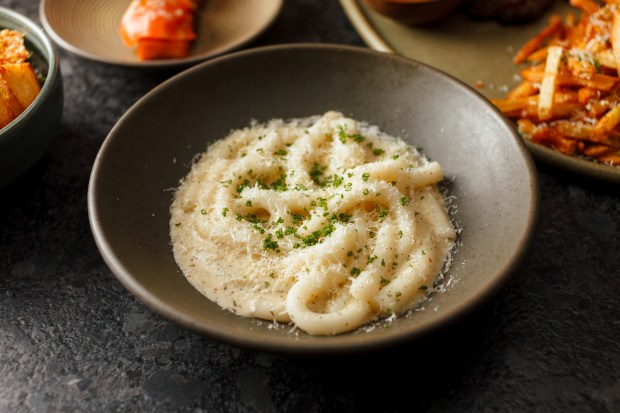
But how’s the beef, you must be asking? The steak was seasoned to bring out the clarity of its marbled, savory beefiness. The Premium Set ($65) featured four cuts of beef — American wagyu hangar steak, wagyu bavette, short rib and marinated short rib — and was cooked by waitstaff on a communal grill. The staff made it easy for us to share, splitting each cut into fork-sized bites.
It’s with the marinated short rib that I really understood what territory Perilla is wading into.
“Traditionally, galbi is a really sweet marinade,” Lim said. “We wanted to do a more savory version of it. A lot of the time the sweetness would blow your palette.”
I quite like the sweetness of galbi, but it’s true; I’ve rarely had galbi where my mind was as laser-focused on the meat’s flavor. I felt slightly deflated at first; my expectations of what I thought galbi should be were not met, even though it was delicious.
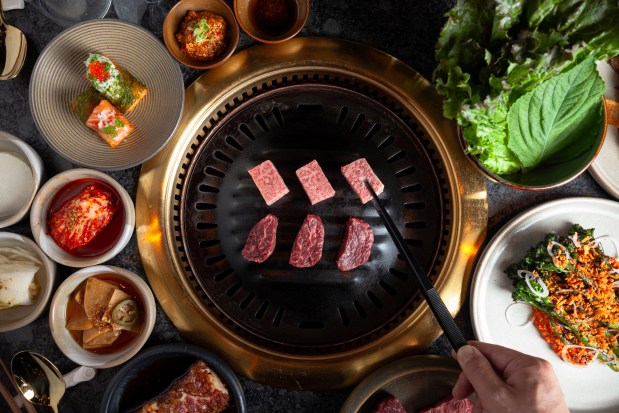
So I returned another day to try another favorite traditional Korean item: soondubu ($16). Even eaten out of a plastic to-go container, there was a polished balance in a simple tofu stew, a nice mix of sweet, spicy and aromatic. And most importantly, the short rib was the best quality meat I’ve had in any soup in recent memory — not typically a place to splurge on good quality meat, but you could really see its value in this context.
Lim and Oh hope to eventually start offering a tasting menu, at high-top tables in the main dining room. They’re still working on the details, but it’s part of their ambitions to go beyond Perilla Fare’s Michelin Bib Gourmand to stars and beyond.
225 N. Wabash Ave., perillachicago.com, 312-236-9300
— Ahmed Ali Akbar
Sando Street
To me, a Japanese sando is iconic. Clear lines, tightly packed, almost too cute to eat. From strawberry and cream fruit sandos to a classic egg salad, that simple yet scrumptious bite is similar to that first-sip-of-coffee feeling. Ah, this is what I was missing.
Am I romanticizing Japanese sandwiches? A little bit. But there just aren’t that many spots in Chicago slinging sandos on shokupan that taste and feel authentic. And in fact, there were a lot of us waiting for the sandos’ arrival. Rich Letheby and Chris Yoo, cousins and co-owners of Sando Street in Wicker Park, said that when they opened on Feb. 16, lines were already down the block. The following Sunday, they ran out of food in three hours.
“My cousin and I had prepped for maybe like a week or two,” Letheby said. “All we had left were chips, and that too we were making on the fly.” That day, they announced on Instagram that they needed more time to prepare for customers and would no longer be open on Mondays.
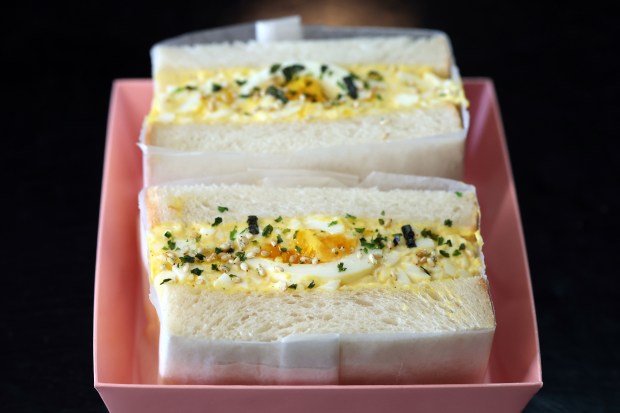
It’s clear that Sando Street is a passion project. Both Letheby and Yoo are thoughtful in their interactions with guests and intentional in how they present each sando. Letheby was previously a sushi chef at Sunda — a pan-Asian restaurant in River North — and said over the past 15 years or so, he’s held a variety of restaurant jobs including managing Roka Akor. He quit his job and took a break to find a way to apply his Japanese Korean roots to make food he’s excited about. With Yoo in his corner convincing him to focus on sandos, it was a done deal.
“It was one of those things where, like 15 to 20 years ago, I said if I ever opened up a restaurant, it’s going to be a Japanese restaurant and I want to play hip-hop,” Letheby said. “We made it come true, here we are — it’s been a wild ride.”
For all of their sandos, both savory and sweet, Letheby and Yoo use shokupan, an ultrasoft, fluffy Japanese milk bread, sourced from Bakery Crescent and Pastry House Hippo in Arlington Heights. It’s what makes a sando a proper sando, said Letheby, who noted that he’d one day like to crack the code and make it in-house. But he needs an oven first.
While I was waiting for my order, a guy walked in and said to Yoo, who was behind the register, “It’s my first time coming here, my friend brought me a sandwich and now I’m in love with it.” He ordered a couple of things, starting with the “KFC,” or Korean Fried Chicken. While “going viral” can certainly jumpstart a business, Letheby said it’s these word-of-mouth drop-ins that sustain their craft.
That quiet afternoon with a booth to myself, I tried the OG tamago ($12), made with Kewpie egg salad, soft-boiled egg and furikake, served of course on milk bread. I don’t want to compare it to the classic lunchbox egg salad sandwich, because it’s elevated and nuanced, but there is a hint of nostalgia there. It’s creamy and smooth, but the Kewpie adds a depth you don’t get with regular American mayonnaise. It is a little messy because the filling oozes out, but I was happily scooping whatever fell out with Sando Street’s house-made Japanese sweet potato chips.
I was most enthused about the picture-perfect fruit sandos, of which they have three flavors: matcha creme ($10), ube creme ($10) and a seasonal, black sesame and cacao creme ($11). I tried each one.
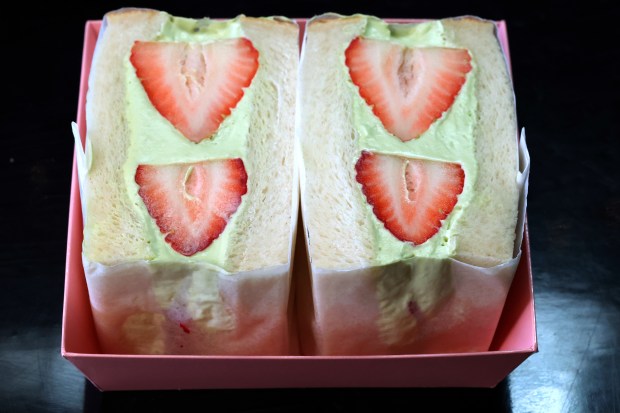
I still can’t decide between the ube and the matcha as my favorite. I’m a matcha regular and was into the combination of fluffy shokupan with the earthy, green-toned whipped cream and fresh strawberries before I even tasted it. Smelled wonderful, too. The ube one surprised me. I think ube tastes similar to vanilla with other undertones at play, such as coconut. I loved it, but I did need to bite back into the savory egg salad to balance my palette. I really, really wanted to like the black sesame cacao sando, which is Yoo’s brainchild, but after having the other two, the black sesame fell short in terms of what I want a classic fruit sando to be. They plan on rotating flavors seasonally, with mango-yuzu on deck again for the summer.
I also appreciated that the fruit sandos hold up in the fridge for two days, especially if bound tightly in plastic wrap.
The $13 KFC sandwich, which is halal, was also a hit. Letheby said he recently made the switch to halal chicken to be able to serve even more people, and because “the quality is better anyway.”
The sando features double-fried chicken thigh, a signature gochujang sauce, pickled cucumbers and chili aioli slaw or pickled slaw (I did the chili aioli) on shokupan. So many textures and flavors I wasn’t expecting all in one bite. And the lightness stood out to me — for a pretty robust sandwich, the bites weren’t heavy and in fact, felt very delicate and healthy, dare I say.
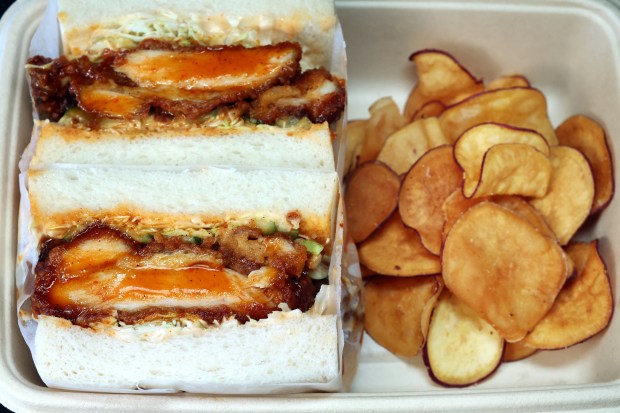
If you go with a group and want to try several different things, I’d recommend ordering one of each sando and sharing halves. While the main draw is sandwiches — with choices that cater to vegetarians and vegans — they also have rice bowls and gyoza.
Personally, I went for the fruit sandos but will go back for so much more.
1547 N. Ashland Ave., sandostreetchi.com, 773-698-6475
— Zareen Syed
Santa Masa Tamaleria
I’ve written about how the holiday season means making and eating tamales together for many Chicago families. So when it came time for our biannual review roundup, visiting a place specializing in those nurturing, family-created dishes made perfect sense.
In the Northwest Side’s Dunning neighborhood, chefs Jhoana Ruiz and Danny Espinoza and their family are slinging inventive tamales, tacos and breakfast plates. Their bricks-and-mortar space opened in June, catering to loyal followers, who remember their Italian beef tamales from their pop-up days, and newcomers alike.
Both Ruiz and Espinoza are industry veterans raised in families of food entrepreneurs, with Espinoza’s roots in Michoacán, Mexico, and Ruiz’s in Mexico City. Here they showcase how the tamal, sold on street corners and supermarkets across Chicago and a staple of Mesoamerican cuisine for centuries, can be a vessel for culinary flair.
“It’s been amazing, plain and simple, showcasing ‘grandma’ cuisine,” at Santa Masa, Espinoza said.
The couple cooked in Michelin-starred Mexique with chef Carlos Gaytan. Before the pandemic, Espinoza was executive chef at Cantina Laredo. Ruiz, who formerly cooked at Everest, quit her job as an executive banquet chef at the United Center to do Santa Masa full time. Espinoza still works as a corporate chef during the week, and cooks at Santa Masa on the weekends.
On a recent visit, I ordered a tamale spread, with a heaping cup of café de olla, ladled from a steaming stovetop pot, to wash it down. Plus, I sampled their delicious weekend-only pozole ($17).
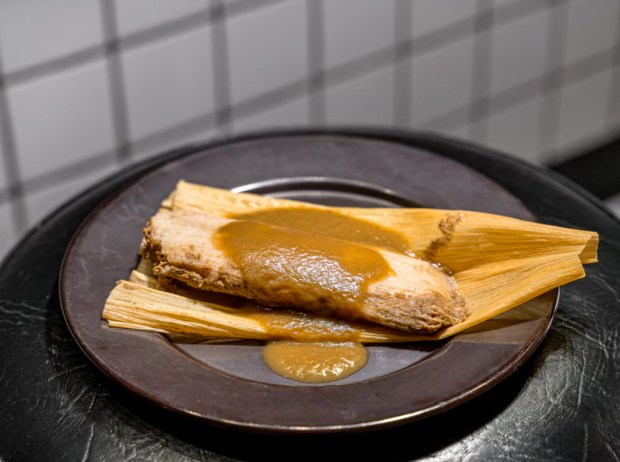
Each tamal came out neatly plated on its husk or banana leaf. My order of their bestselling rajas con queso tamal ($3), strips of charred poblano peppers and caramelized onions with cheese, was moist and fluffy, layered and packed with savory flavor. The pollo en salsa verde tamal ($3) was also well balanced, with juicy chicken nestled in the non-GMO nixtamalized masa from northern Mexico.
To complete this trio of tamales I ordered the December monthly special: a cochinita pibil tamal ($7) beautifully plated with a mole sauce, radishes, pico de gallo and oranges. The banana leaf-wrapped tamal pays homage to the Yucatan, Mexico, origin of the roasted pork dish. This vibrant explosion of sweet and savory blew me away.
The sauce base, or recado negro, gets guajillo, ancho and arbol chiles. There’s no chocolate in the mole — the sweetness was instead rooted in vanilla spice.
This month they’re doing a taco suadero-inspired braised beef tamal and a sweet pineapple tamal with toasted coconut and a walnut streusel topping. Ruiz and Espinoza are teasing a red velvet tamal for February.
Don’t forget to add a side order of rice ($4) and beans ($4) to accompany each tamal bite. The rice was orange and fluffy and the beans were rich, with a layer of queso melted on top.
A silky atole ($4), which felt like drinking a warm hug, was another standout. They boil water and milk with cinnamon and piloncillo and combine it with masa.
“Growing up with it, that was my chocolate milk in the morning,” Espinoza said of the drink, which is his grandma’s recipe.
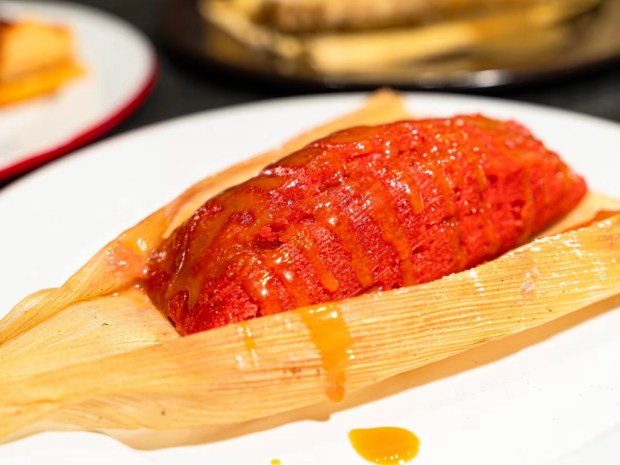
Their resident sweet tamal, a fluorescent red strawberry tamal ($3), is served with a salted caramel sauce. Ruiz leans into her pastry background for the sweet tamales and French toast on the menu. “I treat everything as a pastry item … as far as how we whip them or how we let the dough rise,” she said.
This was my first time trying a sweet tamal, and I wasn’t sure what to expect, but it was buttery and delectable — it sort of tasted like cornbread, and the strawberry flavor was pretty mild overall. “It took me a little bit to get people to try a sweet tamal because most people are accustomed to a savory one,” Ruiz said.
Where I caught snags was during checkout. I was issued the wrong receipt and had to redo the transaction. That being said, food infused with creativity, passion and family love is the draw.
“We’re doing food that makes us happy, and makes our family proud,” Espinoza said.
7544 W. Addison St., santamasa.com, 312-982-9306
— Lauryn Azu
Big screen or home stream, takeout or dine-in, Tribune writers are here to steer you toward your next great experience. Sign up for your free weekly Eat. Watch. Do. newsletter here.


